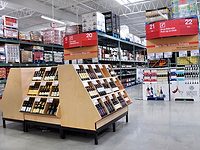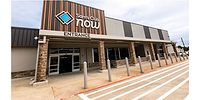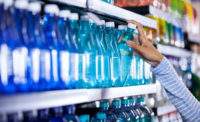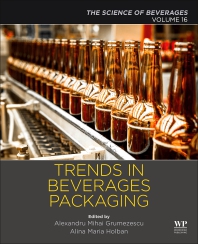Club Store Packaging for Beverages
By JOANNA COSGROVE
Just because it’s ‘bulk’
doesn’t mean it can’t be convenient and portable
Club stores, or warehouse
stores, are one of the fastest growing retail channels, with shoppers
ringing up an average purchase of $82.73 per trip, according to ACNielsen.
Beverages play a big part in the club store landscape, but bulk packaging
for beverages can be a tricky proposition. Sure it’s cost effective
to buy a 2-gallon bottle of apple juice, but
how user-friendly is the bottle that apple juice is packaged in? Is it easy
to carry, store and use after it is brought home? Those are just a few of
the issues packaging companies are helping beverage manufacturers address
when they make the leap into the club store arena.
The club store’s uniform merchandising scenario
makes package choice and graphics critical points of differentiation. A
primary difference between beverages packaged for sale in a traditional
retail environment vs. those in the club store is the heightened need for
practicality. As Amie Thomas, marketing director at PakTech, Milwaukee,
Wis., puts it, packaging needs to be “more utilitarian than
clever.”
The club store offers an occasion for stock up and
value. The challenge lies in offering the right serving size in the right
package, knowing customers are expecting better-than-average value for
their money. “Research tells us portability and ease of handling at
point of consumption are important attributes, so in the club channel you
best have a bulk package that breaks down into manageable branded serving
units,” says George McClory, field marketing manager at ITW Hi-Cone,
Itasca, Ill.
In an effort to bring a “total packaging
solutions system” to the club-store market, International Paper,
Memphis, Tenn., can provide processors with a 64-ounce multi-pack case
designed to balance value with convenience. This product offering can
enclose either two, three or four 64-ounce gable-top cartons in an
easy-to-carry corrugated case with side handles and high-definition
process-print graphics.
“With this product, consumers get the value of a
larger volume of dairy or juice products in a packaging format they can
keep fresh at home,” says Jeanette Havens, assistant marketing
manager for beverage packaging at International Paper.
International Paper also produces multi-packs for
single-serve beverages. HomeMakers Premium Not-From Concentrate Orange
Juice, which recently launched in club stores, employs a multi-pack of 24
single-serve Micro-Pak cartons. Each 6-ounce package features litho
graphics, barrier boards to protect the juice’s taste and nutritional
content, an easy-to-use foil straw patch, a small cross-section that is
easy to hold, and a no-rock pyramid bottom that prevents the carton from
spilling. Consumers can purchase 24 of these cartons in colorfully printed
cases. “[It’s] a great solution for the family that shops club
stores,” says Havens. “It provides a high-quality nutritional
beverage, convenient packaging that kids and parents can use on the go, and
the value that’s expected at club stores.”
Handy handles
Alternate packaging for canned and bottled beverages
presents another unique challenge: how to collectively and conveniently
package cans or bottles without using cardboard trays or boxes that conceal
the product. “Many consumers are attracted to minimal packaging and
like the ability to see what they are actually buying,” says
Hi-Cone’s McClory. “One suggestion is to show off the branded
primary container and complement it with subtle tertiary packaging.
Combining Hi-Cone’s unique carrier bundling quality and standard
shrink film is an example.”
“The ‘warehouse’ price point
requires that processors either make their container larger or bundle the
smaller containers in a fashion unique from the retail multi-pack,”
adds Thomas, whose company, PakTech, manufactures handles for unitizing a
variety of containers. “PakTech handles are designed with smooth
edges to hold heavier products comfortably. Our clients come to us with a
container and format in mind, and we either fit them with a stock handle,
or we provide a custom handle development plan.”
Handles are a standard presentation in club stores.
PakTech’s UniPak bale handles are used on Hawaiian Punch and
Nestlé water gallons, among others, and the company serves many of
the major beverage companies sold in club stores.
Last year, PakTech helped Eurobubblies, a Santa
Monica, Calif.-based producer of non-alcoholic sparkling juices packaged in
champagne-style bottles, refine the presentation for its three-pack
package. “They used a paperboard package, but believed that the
paperboard alone did not achieve the ‘consumer-friendly’
package they were looking for,” recalls Thomas.
PakTech created an in-line 3Pak with a hand-applied
bale handle. The “mixed source” package is currently available
in Costco stores.
Picturesque packaging
Visual competition in a traditional retail environment
is fierce but it’s even more of a challenge to attract attention in a
no-frills warehouse environment. Well-designed packaging can help a
beverage grab the attention of potential customers, even if it’s
tucked away in a box or pallet configuration.
Packaging options like printed films can do wonders to
enhance the visual appeal of bulk-packaged beverages. “One of the
best ways to capture the attention of the consumer is to utilize
high-definition graphics and eye-catching color in the product
packaging,” says International Paper’s Havens.
“High-impact printed film designs are a powerful
weapon for helping take advantage of allotted space,” adds Doug
Larson, executive vice president, sales and
marketing at Robbie Manufacturing, Lenexa, Kan. “[They] create a
quality branded image that will help ‘billboard’
product.”
One example is Arizona
Green Tea. Historically presented in plain film only with a printed tray, the company recently provided a brightly printed,
recognizable design to attract new customers while still being recognizable
to current customers.
Of course, value is the most important reason
consumers chose to shop at club stores, and that isn’t lost on
packaging manufacturers. “Price is an important component of club
stores so the low cost of the packaging materials is even more
important,” surmises John Eklund, marketing director at Roberts
PolyPro, Charlotte, N.C. Offering more product for less money is a windfall
for club store customers but the trickle-down effect can hit manufacturers
in the wallet. Packaging companies offer many options to help keep costs
down for the manufacturer, passing an even greater savings — and
value — on to the consumer. BI




